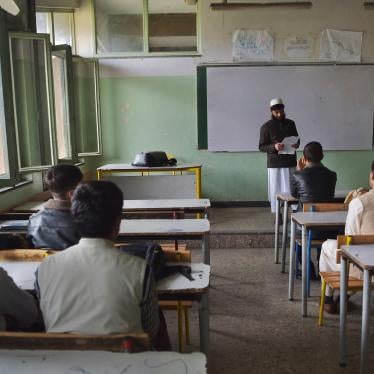Submission by Human Rights Watch to the Legislative Affairs Office of the State Council on the proposed amendments to the Regulations of Education of Persons with Disabilities in China
March 25, 2013
Human Rights Watch, an international nongovernmental organization that monitors and reports on human rights in about 90 countries around the world, welcomes the opportunity to provide comments on the draft amendments (“the amendments”) to the 1994 Regulations of Education of Persons with Disabilities in China (“the 1994 Regulations”), which were published on February 25, 2013.[1]
Human Rights Watch monitors the situation of persons with disabilities globally, and advocates for compliance with the Convention on the Rights of Persons with Disabilities (CRPD).[2] On China specifically, Human Rights Watch submitted information to the Committee on the Rights of Persons with Disabilities (“the CRPD Committee”) for its review of China in 2012, and we are currently undertaking research on access to education in China.
Human Rights Watch commends the Chinese government’s efforts to amend the 1994 Regulations to comply with the CRPD, which China ratified in 2008. The amendments reflect a number of positive steps toward addressing current barriers to access to education for persons with disabilities. For example, the amendments describe funding allocations, teacher training, and the responsibilities by various government departments and quasi-governmental bodies in the education of persons with disabilities. The amendments also refer to the important concept of “reasonable accommodation” and require that schools develop individualized educational plans with corresponding evaluation standards for students with disabilities.
However, Human Rights Watch remains concerned about the following issues:
1. Lack of strategy towards “inclusive education”
The CRPD requires that state parties “ensure an inclusive education system at all levels.”[3] While it takes time to transition from special schools to a fully inclusive education system, the Chinese government does not appear to be committed to this goal as there is no clear plan towards “the goal of full inclusion”[4] in education, as stipulated by the CRPD. The government is currently operating two parallel systems of education for persons with disabilities: general schools in which persons with disabilities “study along with the class,” and special education schools in which students with disabilities are segregated according to types of disabilities.[5]
The amendments continue to affirm a segregated system of special education institutions. Article 23 commits the government to building new segregated schools including at the tertiary level.[6] Under the amendments, persons with disabilities will be placed in either of the two systems “according to the types of disabilities and their learning abilities”[7] and their “ability to receive an ordinary education,”[8] thus segregating a category of persons with disabilities from the regular school system. This is likely to reinforce the existing situation in which general schools only admit and retain children with physical disabilities or mild forms of other disabilities. This is inconsistent with the CRPD, which requires that persons with disabilities “are not excluded from the general education system on the basis of disability.”[9]
In its review of the Chinese government’s compliance with the CRPD in September 2012, the CRPD Committee also expressed concerns with the “high number of special schools and the State party’s policy of actively developing these schools” and recommended that the government “reallocates resources from the special education system to promote the inclusive education in mainstream schools.”[10] Yet the amendments suggest that these recommendations will not be followed.
In addition, article 13 of the amendments allows local governments in “areas that do not meet the requirements or those with special difficulties” to “make arrangements such that [children with disabilities] are enrolled in appropriate schools.” These provisions appear to waive local government responsibilities to inclusive education in broadly defined and vague situations. Article 14 also allows local governments to designate certain regular schools in the area to take children with disabilities when other schools “do not have appropriate education and teaching abilities.” This might lead to the concentration of these children in particular schools that can create segregated classes or de facto segregated schools. This could also place burdens on families to transport children, especially those with some mobility disabilities, unnecessarily long distances to attend school.
The amendments also do not ensure that special education institutions interact with the wider community, or that children in special education classes located in mainstream schools interact with other children without disabilities. Until such time as it achieves a fully inclusive education system, the government should facilitate the interaction between children in special schools and special classes and those in regular schools and regular classes, by establishing activities in which these children interact regularly.
The use of the term “integrated” education (ronghe jiaoyu) throughout the amendments is also problematic. Integrated education needs to be distinguished from the system of inclusive education (quanna jiaoyu). An inclusive approach to education focuses on identifying and removing the barriers to learning and changing practices in schools to accommodate the diverse learning needs of individual students.[11] However, integrated education tends to regard the child itself as the problem rather than addressing the system-wide barriers in the education system.[12]
2. Deficiencies in the proposed system for children with disabilities
The amendments also establish a multi-disciplinary Steering Committee on the Education of Persons with Disabilities (残疾人教育指导委员会) (the “Steering Committee”) that will evaluate a child’s “ability to receive an ordinary education.”[13] This raises serious concerns of how a child and their capacity to learn may be judged and what should be the scope of the Steering Committee’s mandate. For example, the Steering Committee should not have responsibility for school placement but rather for recommending the type of support and accommodation to be provided to students with disabilities.
Furthermore, there is no indication if persons with disabilities and their independent representative organizations will be involved in this assessment, as required by article 4(3) of the CRPD. It is also unclear if the child will be evaluated by each member of the Steering Committee individually and on an annual or other basis. Furthermore, the Steering Committee only plays an advisory role and has no decision-making power vis-à-vis the schools. Thus, it is unclear if, at the end of the evaluation, a child will actually be enrolled in a school and provided with reasonable accommodation.
3. Insufficient redress mechanisms
According to article 16 of the amendments, parents unsatisfied with the “arrangements with regard to their children’s enrollment”[14] can appeal to the Steering Committee. However, since the mandate of the Steering Committee is to evaluate the child’s suitability to be educated in a general school, it appears that parents might only be able to dispute this assessment. The problem is that this redress system focuses on the disability instead of on identifying barriers in the schools’ practices and removing them to guarantee the child’s access to an inclusive school in the general education system. There is no clear redress mechanism if parents are unsatisfied with the assessment of the Steering Committee.
Furthermore, according to article 26, once a child has been placed in a special education school, only the school can recommend and initiate the transfer of the child into a mainstream school if the child is deemed able to adjust to mainstream schools.[15] Parents can consent (or object) to the school’s recommendation, but the amendments do not give them the right to initiate a transfer.
4. Lack of clarity on reasonable accommodation and other support
Articles 8 and 19 require that schools tailor education to the individual needs of children with disabilities and that they should provide accommodation and assistance to these students. However, there is no definition of accommodation or examples of the kind of support schools are obligated to provide to students with disabilities except for the establishment of “resource rooms” in article 15.[16] The “1994 Regulations” already stipulate that schools offer “help to the special learning and rehabilitation needs”[17] of the children, and yet children with disabilities in general schools often receive little or no support to meet their education needs. In the absence of more concrete details, it is possible that schools might continue to fail to fulfill these obligations.
In addition, the amendments do not specifically address other services that facilitate education for children with disabilities, such as physical therapy, occupational therapy and vision and speech therapy. In that regard, references to “rehabilitation” in the amendments should be modified to “habilitation and rehabilitation,” to reflect that some skills are being taught to children for the first time and to comply with article 26 of the CRPD. Furthermore, the amendments do not provide guidance on what services (habilitation and rehabilitation) children with disabilities should receive at home, in addition to school. These services are critical to achieving the goal of full inclusion of the child in society.
5. Lack of mechanism to address dismissal of students with disabilities
Although the amendments in articles 14, 20 and 48 address schools’ denial of admission to children with disabilities, it fails to address the dismissal of children with disabilities from school. This has been another common way in which children are denied access to education in the general system and then placed in a special needs school.[18]
6. Continued discrimination on school admission and hiring of teachers
In terms of access to higher education, article 20 of the amendments states that institutions cannot refuse to enroll students on the basis of disability and that they “shall preferentially enroll candidates with disabilities who meet admission requirements.”[19] At the same time, however, the amendments continue to facilitate discrimination on the basis of disability: the same article states that admittance is conditioned upon the students’ ability to “take care of their own lives,”[20] vague standards that allow schools to arbitrarily deny admission to persons with disabilities.[21] In addition, the amendments endorse existing government policy of imposing physical requirements in student admission and only in certain professions deemed “suitable for persons with disabilities”[22] would such requirements be “lowered.”[23] Students applying to enroll in universities are already required to submit to a detailed physical examination. Even when the applicants have met the necessary academic requirements, schools can still deny them admission, or dissuade them from applying to certain subjects, if they have certain categories of “physiological defects” and “mental disorders” as defined and listed in a joint guideline document issued by the Ministry of Education, the Ministry of Health and the Chinese Disabled Persons Federation (CDPF).[24]
Similarly, the amendments also reinforce existing government policy that allows schools to discriminate against persons with disabilities in the hiring of teachers. Article 34 of the amendments state that government departments as well as schools should “relax physical requirements” on the candidates “depending on the job characteristics and types of disability” implying that it is acceptable, in some instances, to discriminate individuals on the basis of physical requirements. In 2011, a survey conducted by a disability rights activist found that relevant government policies on teachers’ qualifications in 20 out of 21 provinces where information was available include discriminatory provisions against persons with disabilities.[25]
7. Lack of information on right to education
The CRPD Committee requested the Chinese government to “inform all persons with disabilities, especially those living in rural areas, of their rights, specifically the right to…attend schools.”[26] Yet the proposed amendments do not include provisions to reach out to children with disabilities and their families to ensure that they are informed of their right to education. According to Chinese government statistics in 2010, about 71 percent of children with disabilities were enrolled in schools during the compulsory education stage.[27] Considering the fact that nearly all children in China go to school at this stage, there is a significant gap in enrollment rates of children with and without disabilities. Our preliminary research has found that parental attitudes, as well as attitudes of officials and school administration, are barriers to accessing education as both the family and the communities consider children with medium to severe disabilities as unable to learn. Parents of children who are not in school who were interviewed by Human Rights Watch are generally unaware of the rights of their children, including the right to education, and most are unclear about the education options available.
Recommendations
The Chinese government should revise the amendments to bring them in line with the Convention on the Rights of Persons with Disabilities. Specifically, the new regulations should:
- State clearly that the Chinese government is committed to “the goal of full inclusion” as set out in article 24 of the CRPD. In this regard, as recommended by the CRPD Committee, the government should develop and implement a strategic plan to “reallocate resources from the special education system to promote the inclusive education in mainstream schools”[28] drawn up by consulting closely with “persons with disabilities…through their representative organizations”.[29]
- Replace the term “integrated education” with “inclusive education” throughout the amendments and define “inclusive education” in accordance with article 24 of the CRPD.
- Define “reasonable accommodation” in the regulations in accordance with article 2 of the CRPD, and stipulate that relevant government departments are responsible for ensuring that schools provide persons with disabilities with reasonable accommodation within the general education system.
- Revise articles 13 and 14 of the amendments to remove language that allows responsibilities to inclusive education be waived in certain situations.
- Shift the role of the Steering Committee on the Education of Persons with Disabilities from assessing the disabilities (their “physical condition” and “ability to receive an education”) of students to evaluating their educational abilities and needs and ensuring that reasonable accommodation and individualized support are provided in the general education system to meet these needs.
- Explicitly state that people with disabilities (including children) and their families should actively participate in the individual assessment of the child with disability as part of the Steering Committee.
- Provide that each child should be evaluated on an individual basis by each member of the Steering Committee and on a regular basis; also, add a provision that members of the Steering Committee (which would include the parents of the child with disability) meet regularly to share information about the child’s progress.
- Specify habilitation and rehabilitation needs, including that services should also be provided at home.
- Before a fully inclusive system is in place, state clearly in the regulations that in the interim, special education institutions and classes should take measures to ensure that children with disabilities in these segregated settings are able to fully participate in their education in the community. Examples could include encouraging that children with and without disabilities participate together in some classes (such as arts and music).
- Remove the phrases “ability to take care of their own lives” or any other provisions that allow schools to discriminate potential students or teachers on the basis of physical characteristics or abilities.
- State explicitly in article 48 that schools’ dismissal of students on the basis of disabilities is an action that is punishable by the relevant education departments.
- Include a provision in the regulations that mandate the CDPF to inform parents of their children’s rights to education and of their education options in their outreach programs.
- Establish an impartial hearing mechanism through which parents of children with disabilities could lodge complaints if they are dissatisfied with the evaluation of the Steering Committee, and that such redress mechanism should complete the review within a certain reasonable time.
- Establish an independent body made up of independent disability experts and representatives of children with disabilities and their parents to monitor compliance with the amended regulations, identify any remaining barriers to access quality and inclusive education, and make recommendations to the Ministry of Education regarding further amendments.
[1] 国务院法制办公室,“国务院法制办公室关于《残疾人教育条例(修订草案)(送审稿)》公开征求意见的通知,” February 25, 2013, http://www.chinalaw.gov.cn/article/cazjgg/201302/20130200384148.shtml
[2]International Convention on the Protection and Promotion of the Rights and Dignity of Persons with Disabilities(CRPD), G.A. Res. 61/106, Annex I, U.N. GAOR, 61st Sess., Supp. No. 49, at 65, U.N. Doc. A/61/49 (2006), entered into force May 3, 2008. China ratified the CRPD on August 1, 2008.
[3] CRPD, art. 24(1).
[4] CRPD, art. 24(2)(e).
[5] Initial reports submitted by China under article 35 of the Convention on Implementation of the Convention on the Rights of Persons with Disabilities, February 8, 2011, para. 22.
[6] Amendments, arts. 4 and 24.
[7] Amendments, art. 4.
[8] Amendments, art. 14.
[9] CRPD, art. 24(2)(a).
[10] Committee on the Rights of Persons with Disabilities, Concluding observations on the initial report of China, adopted by the Committee at its eighth session (17–28 September 2012), October 15, 2012, para. 36
[11] Specialized classes within mainstream schools may be beneficial for some students with disabilities to complement or facilitate their participation in regular classes, such as to provide Braille training or physiotherapy.
[12] UNICEF, “A Rights-Based Approach to Inclusive Education: Position Paper,” 2012, p.12, http://www.unicef.org/ceecis/UNICEF_Right_Children_Disabilities_En_Web.pdf.
[13] Amendments, art. 14.
[14] Amendments, art. 16.
[15] Amendments, art. 26.
[16] Amendments, art. 19.
[17] 1994 Regulations, art. 21.
[18] Amendments, arts. 14, 20 and 48.
[19] Amendments, art. 20.
[20] Amendments, art. 20.
[21] See, e.g. Shen Wei and Shou Lijun, “生活难自理汤东林被退档家人表示愿签协议全程陪读,” July 26, 2006, http://www.why.com.cn/epublish/node4/node6062/node6064/userobject7ai56242.html [accessed March 18, 2013].
[22] Amendments, art. 20.
[23] Amendments, art. 20.
[24] The Ministry of Education, the Ministry of Health and the CDPF, “Guiding Opinion on Physical Examinations in the Recruitment of Students in Ordinary Higher Education Institutions (普通高等学校招生体检工作指导意见),”issued on March 3, 2003.
[25] See Zheng Xiaoqian and Shi Caiying, “至少20个省市教师资格体检标准涉嫌歧视残疾人,” Henan Shangbao, September 10, 2011, http://www.ce.cn/xwzx/gnsz/gdxw/201109/10/t20110910_22686541.shtml [accessed February 7, 2013].
[26] Committee on the Rights of Persons with Disabilities, Concluding observations on the initial report of China, adopted by the Committee at its eighth session (17–28 September 2012), October 15, 2012, para. 16.
[27] The percentage of children with disabilities not in school, 16 per cent, was calculated using the following numbers: the number of children out of school (126,000, data available from the CDPF) and the number of children with disabilities in school (398,700 in special education schools plus 225,200 in mainstream schools, data available from the Ministry of Education). CDPF, "2001 National Disabled People Development Statistics Bulletin (2011年中国残疾人事业发展统计公报)," http://www.gov.cn/fwxx/cjr/content_2104842.htm [accessed April 24, 2013]; Ministry of Education, "2011 National Education Development Statistics Bulletin (2011年全国教育事业发展统计公报)," http://www.moe.edu.cn/publicfiles/business/htmlfiles/moe/moe_633/201208/... [accessed April 24, 2013].
[28] Committee on the Rights of Persons with Disabilities, Concluding observations on the initial report of China, adopted by the Committee at its eighth session (17–28 September 2012), October 15, 2012, para. 36.
[29] CRPD, art. 4





